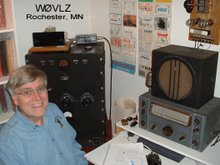
Today I participated in the annual QRP FYBO (Freeze Your B___ Off) contes
 t. See http://www.azscqrpions.org . It happened that we are into a little warm spell after several weeks of below freezing weather. The temperature was 40 at 10AM when I got started, rose to 46 around lunchtime and then dropped into the 30s by the time I got off the air at 3:15. I'm not a big contester. With on and off operating and marginal band conditions I made only 5 contacts on 40 and 20 CW for 800 points. Most hams I worked were relatively warm, only VE3RRP in Ontario was below freezing.
t. See http://www.azscqrpions.org . It happened that we are into a little warm spell after several weeks of below freezing weather. The temperature was 40 at 10AM when I got started, rose to 46 around lunchtime and then dropped into the 30s by the time I got off the air at 3:15. I'm not a big contester. With on and off operating and marginal band conditions I made only 5 contacts on 40 and 20 CW for 800 points. Most hams I worked were relatively warm, only VE3RRP in Ontario was below freezing.The FYBO Contest did give me a chance to get out of the basement shack. One of the neighbors interrupted a snowman build to find out why I was lounging on my deck in February. Even with temperatures hitting the mid 40s it is still winter in Minnesota.
I found the FYBO Contest a challenging and fun break from my regular winter boatanchor activity. I'll do it again next winter.

















